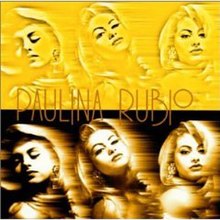| La Chica Dorada | ||||
|---|---|---|---|---|
 | ||||
| Studio album by | ||||
| Released | October 20, 1992 | |||
| Recorded | December 1991 – February 1992 | |||
| Studio | Balu-Balu (Madrid, Spain) | |||
| Genre | ||||
| Length | 37:58 | |||
| Label | EMI Capitol de México | |||
| Producer | ||||
| Paulina Rubio chronology | ||||
| ||||
| Singles from La Chica Dorada | ||||
| ||||
La Chica Dorada (English: The Golden Girl) is the debut solo studio album by Mexican singer Paulina Rubio, released on October 20, 1992, by EMI Capitol de México.[1] The album was produced and directed by Miguel Blasco, and written mostly by José Ramón Flórez, Gian Pietro Felisatti and Cesar Valle. Most of the album's composition is primarily "a light and danceable pop", although it includes some elements of pop rock, new jack swing, new wave and a couple of ballads. The album's title has been stuck as Rubio's nickname throughout the Spanish-speaking world ever since.[2]
The album received a mixed reception from music critics. Many applauded the album for its deployment of genres within pop, as well as Rubio's transition "from girl to woman", while others focused heavily on the singer's conceptual image, noting the obvious influence of Marilyn Monroe and Madonna[3] —although her greatest inspiration was Brigitte Bardot—, and thus frowned upon another "Madonna wannabe" in the music industry. Commercially, La Chica Dorada was a success in Latin America and the United States. It peaked at number two on the Billboard Latin Pop Albums, while in Mexico it was certified platinum and three-times gold.
Four singles were released from the album, all of which attained commercial success in the United States. Its lead single "Mío" reached number three on the Billboard Hot Latin Songs, and it was certified gold in Mexico.[4] The subsequent singles in US, "Abriendo las Puertas al Amor" and "Amor de Mujer", both peaked within the top-ten of the chart, while the four and final single, "Sabor a Miel", entered within the top-twenty. La Chica Dorada's commercial success helped Rubio establish herself as a Latin pop idol and launch her recording career.
- ^ "Paulina Rubio Official Website: Discography -La Chica Dorada". paulinarubio.com. 2012. Archived from the original on April 26, 2012. Retrieved February 16, 2013.
- ^ Paulina Rubio dice que sus próximos cincuenta años de vida serán “sin ataduras”; alista gira para 2022
- ^ "Paulina Rubio dice que es un orgullo que la califiquen como la "Madonna latina"". Retrieved 14 October 2018.
- ^ "Magic's In The Music And The Music's In These". Billboard. March 13, 1993. Retrieved October 7, 2018.